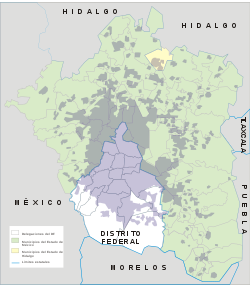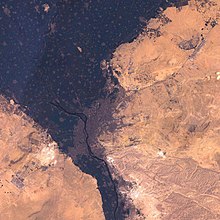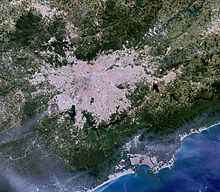Megalopolis
The term megalopolis (from the Greek language Μεγάλη (Megáli) -great- πόλις (pólis) -city-) or megapolis is applied to the set of metropolitan areas, whose accelerated urban growth leads to the contact of the area of influence of one with the others. In short, megacities are usually made up of conurbations of large cities.
The term megalopolis was introduced by the French geographer Jean Gottmann in 1961, in his book, Megalopolis, The Urbanized Northeastern Seaboard of the United States ("Megalopolis, the urbanized maritime northeast of the United States"), referring to that urban system that had a population equal to or greater than 10 million inhabitants. In Spanish, the most used term is city-region.
The first definition used by Gottmann for "megalopolis" it pertained to the agglomeration between Boston and the Baltimore-Washington D.C. conurbation including the agglomerations of Hartford, New York, New Jersey and Philadelphia, as well as a multitude of cities of more than 100,000 inhabitants on the East Coast of the United States. Such a gigantic conurbation already existing in the middle of the XX century has also received the name BosWash (compound acronym by the first syllables of Boston and Washington, names of the two cities located at the ends). Such an urban ensemble extends for more than 800 kilometers from north to south and has a population of between 65/70 million inhabitants.
Gottmann explains that this demographic and power concentration (economic, political, judicial, cultural) in such a space was due to the succession of favorable circumstances: the colonial history of the United States and the importance of trade with Europe, the victory of the North against the South in the Civil War (eliminating competition from southern ports -for example, New Orleans-) and the presence of an industrial and financial bourgeois elite supported by a transcountry or inland territory close to the rich megalopolis in iron, coal and hydraulic power.
The author tends to present such an American Megalopolis as a new Rome: " fait un peu figure à l'époque présente de ce que fut la Rome impériale du monde antique. L'Atlantique semble être la Mare Nostrum de cette nouvelle Mégalopolis aux dimensions extraordinaires (Made a bit of a figure in the present era of what was the imperial Rome of the ancient world. The Atlantic seems to be the Mare Nostrum of this new Megalopolis of extraordinary dimensions).". This comparison anticipates the analysis that leads to three urban development centers presented in 1975 in the Triad of Ken'ichi Ōmae. Other megalopolises were subsequently identified and analyzed by other scholars in the 1960s and 1970s. Doxiadis studied the Great Lakes megalopolis, Peter Hall the English megalopolis, Isomura the Japanese Tokaido megalopolis, other Italian scholars such as Muscara the possible "megalopolis& #3. 4; mediterranean.
It is easy to find examples of megalopolises, since any large city is expanded with satellite cities that can be satellites of other large cities, creating a megalopolis. These demarcations are useful for regional planning in transportation and communications.
Se[who?] has included the concept of global city as an extension of the megalopolis and when warranted as a political category or economic or cultural.[citation required]
When talking about a megalopolis, it is convenient to take into account the scale of the period, before the XX century the closest thing to a Megalopolises were the great metropolitan cities such as Rome, Alexandria, Janbalic, Constantinople, Baghdad, Teotihuacán, the Spanish Caliphate Córdoba. Although megacities in the strict (modern) sense of the word are only a phenomenon of industrial society from the XX century in which massive and continuous global migrations take place.
There is criticism of the estimates of these nuclei, given their excessive surface area and the inclusion of large empty areas.[citation needed] The governability of the megalopolis with settlements in various states or provinces, which makes its dimensions difficult to quantify, as there is no centralized administration.[citation required] In the urbanization process basically When two or more metropolises unite, a large conurbation or megalopolis is formed, which is a different concept of a city with new solutions and new problems.
Examples
Africa
At present, the African continent presents examples of demographic megalopolization typical of the "Third World" (or economic underdevelopment), it is about rapid and rather chaotic population growth at certain points due to these main factors: the high birth rate, the massive emigration from the countryside to the city due to rural backwardness that makes it impossible to sustain the population of rural areas, the concentration of the few economic resources of the countries in the old colonial capitals, the bureaucratic centralization in such capitals.
In this way they can be considered Cairo (in Egypt) or Lagos (in Nigeria); The South African case is more complex since the megalopolis is economically more decentralized.
America
In the United States, the urban area consisting of Boston, Providence, Hartford, New York, Philadelphia, Baltimore, Washington D.C., and other smaller metropolitan areas, known as BosWash or the Northeast Corridor, the largest and most populous area in the Western Hemisphere (65 million inhabitants).
The cross-border megalopolis between the United States and Canada of the Great Lakes region, which brings together the metropolitan areas of Green Bay, Milwaukee, Chicago, Fort Wayne, Toledo, Detroit, Cleveland, Erie and Buffalo in the United States and the of Niagara Falls, Toronto, Ottawa, Montreal and Quebec in Canada plus several minor cities, such a megalopolis of the Great Lakes basin (including the Saint Lawrence River valley) brings together some 60 million inhabitants. The US part is known as the Rust Belt, while the Canadian part is called the Quebec-Windsor Corridor.
In the United States, the urban area located in California between the metropolitan areas of San Francisco and San Diego - Tijuana has also come to be considered a megalopolis called SanSan, this includes the metropolitan areas of Los Angeles, Sacramento, and other smaller ones such as Stockton, Fresno and Bakersfield (more than 35 million inhabitants). Although if you include the Tijuana Metropolitan Area (City conglomerated with San Diego, California, USA) it would have more than 37 million inhabitants.
In Mexico, the Regional Crown of the Center of the Country around the Valley of Mexico together with the metropolitan areas of Puebla - Tlaxcala, Cuernavaca - Cuautla, Toluca, Pachuca, Tula de Allende, Tulancingo. Considering other smaller populations that exist in the Valley of Mexico and its area of influence, it would reach a total population of more than 38.6 million inhabitants.
Also in Mexico, the Bajío Metropolitan Region, a megalopolis formed by geographical and cultural conditions and by the proximity of the cities of the different states that make up the Mexican Bajío and that is part of the Central-north region of Mexico, would reach a total population of 11 million inhabitants.
In Brazil, the coastal zone between Rio de Janeiro and São Paulo, together with other urban areas in the interior of the state of São Paulo, can be considered a megalopolis, with more than 40 million inhabitants.
In Argentina, a megalopolis has developed on the right bank of the Paraná and La Plata rivers between Greater Buenos Aires and Greater La Plata at its southern end, and Greater Santa Fe and Greater Paraná to the north, encompassing the Great Rosario and other smaller urban areas. Such a megalopolis exceeds 20 million inhabitants.
In Peru, the centralization of powers generated the embryo of a megalopolis on the central coast of the country, which includes metropolitan Lima (Lima and the port of Callao), which concentrates 9.6 million inhabitants in 2013, along with other urban areas to the north, south and east of the metropolis, as well as some towns within a range of 200 km. In total, the agglomeration exceeds 10.5 million inhabitants.
In Venezuela, in the so-called Cordillera de la Costa, are some of the most populated cities in Venezuela: the first, Caracas; the second, Maracaibo; the third, Valencia; the fourth, Barquisimeto and the fifth, Maracay, Guarenas, Guatire, Greater Barcelona, Cumaná, Carúpano, Guiria, the cities of Miranda State integrated into Greater Caracas, Los Teques, San Antonio de los Altos, as well as the towns of Choroní and Chuao, the cities of Carabobo, such as Puerto Cabello and Morón, the cities of Yaracuy state, such as San Felipe and Chivacoa, and the cities of Lara, such as Cabudare, Sanare and Tintorero, have developed a megalopolis that includes about 70% of the total population of the country, about 22 million inhabitants.
In Colombia, the so-called Golden Triangle is the vertex of three of the main cities of the country, Bogotá, Cali and Medellín (possible future Megalopolis), home to more than 60% of the population, generating 80% of the gross domestic product, 76% of manufacturing production, 72% of the construction industry, 75% of commerce, 30% is port, 73% of the service sector, 77% of coffee, 60% of the population is found economically active and 69% of the installed capacity of the electrical network, exceeding 25 million inhabitants [citation required]. Some important cities in the area are: Ibagué, Facatativá, Manizales, Pereira, Armenia, Girardot, Melgar, Zipaquirá. Barranquilla is also considered an important and future Megalopolis, being this city a strategic point in the country due to its location on the Magdalena River and the Caribbean Sea, and its proximity to Santa Marta and Cartagena and the construction expansion in these three cities.
Asian
After the 1980s, the one located in the center of Japan is considered a gigantic megalopolis stretching for more than 1000 km from Tokyo, in the east, to Kitakyushu, in the west, gathering approximately 80% of the Japanese population.
The Japanese megalopolis is made up of three assemblies: the hypercenter around the economic and administrative capital of the country, Tokyo (with 33 million inhabitants) and the Kanto region; then the secondary center connected by the Tokaido shinkansen with the hypercenter called Tōkaidō which is made up of Nagoya and Kansai (Osaka, Kōbe as well as Kyoto), constituting the Kinki triangle (22M inhab.); Finally, the third group is made up in the west by the coastal satellite cities that form a kind of industrial annex to the center.
Other megacities are developing in China with centers in Beijing, Shanghai and the Pearl River Delta, around Hong Kong, Shenzhen and Guangzhou.
India features three megacities around Calcutta, New Delhi and Bombay.
In the Philippines, the one developed around Manila.
Singapore in the small independent state of the same name and Malaysian cities like Kuala Lumpur tend to form a megalopolis.
Jakarta, the capital of Indonesia, is a demographic megalopolis typical of the so-called Third World.
Europe
Defining what a megalopolis is in Europe is quite complex, one can speak of two levels of megalopolis: the large cities whose agglomerations exceed 10 million inhabitants: London, Paris, Moscow, Istanbul or the urban region (not yet fully conurbated) of the Randstad, on the other hand, a much broader definition of the so-called European Megalopolis with more than 70 million inhabitants that would include (very heterogeneously) the area of the West Midlands that goes from London (and its large satellite cities in England, for example Sheffield, Liverpool) to the Milan region in northern Italy passing through the Benelux the Ruhr Basin in Germany, Strasbourg, Basel and the Zurich-Bern-Geneva basin. This European metropolitan arch is also called the European Ridge or the "Blue Banana" by Roger Brunet, in the early 1990s because of the appearance it presents in satellite photographs. Currently tends to include in such a European megalopolis the Parisian agglomerations and Frankfurt am Main and even Turin. Such a "backbone" has been the driving force in political-economic terms of the European Union and still dominates the less demographically gravitating peripheral regions of Europe.
Although in Spain there is no urban center or any conurbation that can be properly classified as a megalopolis, there are urban trends that could result in this type of urbanization: for example, the area that goes from the Spanish cities of Segovia, Guadalajara and Toledo with Madrid as the central city can be considered as a megalopolis or the sum of many micropolises for certain purposes: marketing, television, radio, newspapers, trains, tourism, security, water, shopping centers, hospitals and universities, etc. and as a more restricted metropolitan area: El Escorial, Alcalá de Henares and Aranjuez. These demarcations are useful for regional planning in transportation and communications. Also in Spain-France there is the megalopolis, also called the mega-region, Banana Dorada, which connects the conurbations of Valencia, Barcelona, Marseille and Lyon. If the trends of conurbation and the establishment of linear cities continue at the rate they currently have in Western Europe, it is very likely that the "Blue Banana" soon spread from northern Italy along all the important cities of the Mediterranean coast of the French state and from there to, at least, the cities of the Spanish Mediterranean such as Barcelona and Valencia (in which case the " Blue Banana" at the end of this century XXI would almost be a semicircle -in the shape of an inverted C or ɔ - which would run from England to the coasts of the Spanish Mediterranean).
In Italy two possible megalopolises are pointed out: that of Milan whose urban region includes cities such as Brescia, Monza, Bergamo, Lodi, Crema which constitute, since they lack a solution of continuity, a conurbano of 7 million inhabitants and the central Veneto with the provinces of Vicenza, Padua, Treviso, Venice and Verona, which thanks to the development of the residential sector at the end of the century XX and turn of the century XXI has an almost continuous urban agglomeration of approximately four and a half million inhabitants.
Most populated megacities
The following is a list of some of the main megacities, ordered by number of inhabitants according to Citypopulation estimates:
| N.o | Main City | Population | Growth | Membership |
|---|---|---|---|---|
| 1 | Guangzhou | 46.7 million | 2.4 | Dongguan - Foshán - Jiangmen - Shenzhen - Zhongwan |
| 2 | Tokyo | 40,400,000 | 0.5 | Kawasaki - Maebashi - Sagamihara - Saitama - Utsunomiya - Yokohama |
| 3 | Shanghai | 33.600,000 | - 6.4 | Changzhou - Suzhou - Wuxi |
| 4 | Jakarta | 31.300.000 | 2.3 | Bekasi - Bogor - Depok - Tangerang - South Tangerang |
| 5 | Delhi | 30,300.000 | 3.1 | Faridabad - Ghaziabad - Gurgaon |
| 6 | Manila | 25.700,000 | 2.0 | Caloocan - City Quezón |
| 7 | Bombay | 25.100.000 | 1.6 | Bhiwandi - Kalyan - Thane - Ulhasnagar - Vasai-Virar |
| 8 | Seoul | 24.800.000 | 0.4 | Bucheon - Goyang - Incheon - Seongnam - Suwon |
| 9 | Mexico City | 23,000.000 | 0.9 | Mexico Center Regional Crown - Ecatepec- Naucalpan |
| 10 | São Paulo | 22.400,000 | 0.9 | Guarulhos |
Similar concepts
The concept of megalopolis is practically confused with the concept of megacity is because the two words have the same original meaning, in any case a megacity is not defined only by the number of inhabitants or by the extent of the area it covers, but by the continental or subcontinental influence of its powers (economy, its culture, politics, communications and power in general). The concept of a megalopolis can also be confused with that of a global city, although in the case of a global city what defines it is its global influence, regardless of the variables of resident population or space that such a type of city encompasses. Considering their economic importance (mainly financial) in 2008, three global cities of first degree or first order are considered: New York, London, Tokyo, followed by Paris, Frankfurt am Main, Zurich and Los Angeles.
Contenido relacionado
Brasilia
Anvil rack
Alella
Lakes
Holm oaks below









